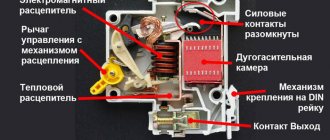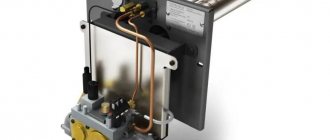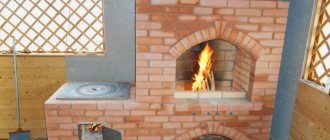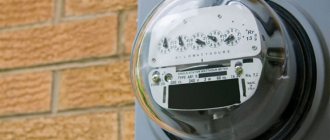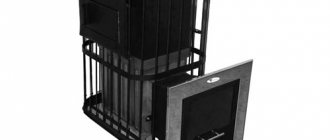Electrical wiring calculations are carried out at the design stage. First of all, the current strength in the circuits is calculated, based on this, automatic protective devices and the cross-section of wires and cables are selected. Of particular importance is the calculation of the machine according to the power of 380, which protects against overloads and short circuits. Too high a rating can lead to equipment failure, since the device will not have time to operate. The low rated current of the machine will cause the protection to operate even with minor overloads during peak hours.
What are circuit breakers for and how do they work?
Modern AVs have two degrees of protection: thermal and electromagnetic. This allows you to protect the line from damage as a result of prolonged excess of the flowing current of the rated value, as well as a short circuit.
The main element of the thermal release is a plate made of two metals, which is called bimetallic. If it is exposed to a current of increased power for a sufficiently long time, it becomes flexible and, acting on the disconnecting element, causes the circuit breaker to operate.
The presence of an electromagnetic release determines the breaking capacity of the circuit breaker when the circuit is exposed to short-circuit overcurrents, which it cannot withstand.
An electromagnetic type release is a solenoid with a core, which, when a high power current passes through it, instantly moves towards the disconnecting element, turning off the protective device and de-energizing the network.
This makes it possible to protect the wire and devices from an electron flow, the value of which is much higher than that calculated for a cable of a particular cross-section.
Type of electromagnetic release
The machine must operate when the current rises above a certain level. But short-term overloads periodically occur in the network. They are usually associated with inrush currents.
For example, such overloads can be observed when turning on the refrigerator compressor, washing machine motor, etc. The circuit breaker should not turn off during such temporary and short-term overloads, because they have a certain delay for operation.
But if the current has increased not because of an overload but because of a short circuit, then during the time that the circuit breaker “wait”, its contacts will melt. This is what an electromagnetic automatic release is for. It operates at a certain current value, which can no longer be an overload.
This indicator is also called cut-off current, since in this case the circuit breaker cuts off the line from the power supply. The magnitude of the operating current can be different and is displayed by letters that appear in front of the numbers indicating the rating of the machine.
There are three most popular types:
- B - triggers when the rated current is exceeded by 3-5 times;
- C - if it is exceeded by 5-10 times;
- D - if 10-20 times more.
Class of machine or cut-off current
What characteristics should you choose? In this case, the choice of a circuit breaker is also based on the distance of your household from the substation and the state of the electrical networks; the choice of a circuit breaker is carried out using simple rules:
- With the letter “B” on the body they are suitable for dachas, houses in villages and towns that receive power supply through air ducts. They can also be installed in apartments of old houses in which the internal electrical network has not been reconstructed. These circuit breakers are not always on sale; they cost a little more than category C, but can be delivered to order.
- Bags with a “C” on the body are the most widely used option. They are installed in networks with normal condition, suitable for apartments in new buildings or after major renovations, in private houses near the substation.
- Class D is installed in enterprises and workshops with equipment with high starting currents.
That is, in essence, the choice of a circuit breaker in this case is simple - type C is suitable for most cases. It is available in stores in a large assortment.
What is the machine used for?
A machine is installed in the power supply circuit to prevent overheating of the wiring. Any wiring is designed to carry a certain current. If the current passed exceeds this value, the conductor begins to heat up too much. If this situation persists for a sufficient period of time, the wiring begins to melt, resulting in a short circuit. A circuit breaker is installed to prevent this situation.
A packager or circuit breaker is necessary to prevent overheating of conductors and shutdown in the event of a short circuit
The second task of the circuit breaker is to turn off the power when a short circuit current (SC) occurs. When a short circuit occurs, the currents in the circuit increase many times over and can reach thousands of amperes. To prevent them from destroying the wiring and damaging the equipment included in the line, the circuit breaker must turn off the power as quickly as possible - as soon as the current exceeds a certain limit.
In order for the protective circuit breaker to properly perform its functions, it is necessary to correctly select the machine according to all parameters. There are not many of them - only three, but you need to deal with each one.
Selecting the breaking capacity
The selection of a packager based on the maximum permissible load current is described above. But the network circuit breaker must also turn off when a short circuit (short circuit) occurs in the network. This characteristic is called breaking capacity. It is displayed in thousands of amperes - this is the order currents can reach during a short circuit. Selecting a machine based on its breaking capacity is not very difficult.
This characteristic shows at what maximum value of the short-circuit current the circuit breaker remains operational, that is, it will not only be able to turn off, but will also work after being turned on again. This characteristic depends on many factors and for accurate selection it is necessary to determine the short-circuit currents. But for wiring in a house or apartment, such calculations are done very rarely, and are based on the distance from the transformer substation.
Breaking capacity of automatic protective switches
If the substation is located close to the entrance to your house/apartment, take a circuit breaker with a breaking capacity of 10,000 A; for all other city apartments, 6,000 A is sufficient.
If the house is located in a rural area or you are choosing an electrical circuit breaker for your dacha, a breaking capacity of 4,500 A may well be enough. The networks here are usually old and the short-circuit currents are not large. And since the price increases significantly with increasing breaking capacity, the principle of reasonable savings can be applied.
Is it possible to install bags with a lower breaking capacity in city apartments? In principle, it is possible, but no one guarantees that after the first short circuit you will not have to change it. He may have time to turn off the network, but will be inoperative. In the worst case scenario, the contacts will melt and the machine will not have time to turn off. Then the wiring will melt and a fire may occur.
Why is a short circuit dangerous?
This situation can arise during repairs if an electrician accidentally shorts the neutral and phase wires together, or due to the destruction of insulation in an adapter box or some electrical appliance.
In this case, the current flowing in the wires can grow to a very large value, limited only by the resistance of the wires and the capabilities of the line. In this case, the current-carrying conductors heat up to the temperature at which the insulation ignites, which can lead to a fire, so it is necessary to immediately turn off the power to the line.
Why turn off the network when overloaded?
No less dangerous is line overload. When more than rated current flows through the wires, they heat up. This leads to destruction of the cable insulating sheath and subsequent short circuit.
The process of heating the wires takes some time, so to protect the line from overload, protection is used that turns off the power to electrical appliances some time after the problem occurs.
| Information! An increased current when starting an electric motor is normal and lasts less than the response delay of the machine. |
The cause of overload may be the simultaneous switching on of high-power electrical appliances, a malfunction of electrical equipment, or the start of an electric motor, for example, in a vacuum cleaner or air conditioner.
If almost any circuit breaker is tripped by a short circuit, then an incorrectly selected device will turn off the power at the rated current of the line or will not be able to protect the wiring from overheating, so before installation it is necessary to calculate the power of the circuit breaker.
Automatic switches for household networks
Electricity supply organizations connect houses and apartments by carrying out work on connecting the cable to the switchboard. All installations of wiring in the premises are carried out by its owners or hired specialists.
To select a circuit breaker to protect each individual circuit, you need to know its rating, class and some other characteristics.
Basic parameters and classification
Household machines are installed at the entrance to a low-voltage electrical circuit and are designed to solve the following problems:
- manual or electronic activation or de-energization of an electrical circuit;
- circuit protection: current cut-off during minor long-term overload;
- Circuit protection: instantaneous shutdown of current in case of short circuit.
Each switch has a characteristic, expressed in amperes, which is called rated current (In) or “rating”.
The essence of this value is easier to understand using the coefficient of excess of the nominal value:
K=I/In,
where I is the actual current strength.
- K < 1.13: tripping will not occur within 1 hour;
- K > 1.45: shutdown will occur within 1 hour.
These parameters are fixed in clause 8.6.2. GOST R 50345-2010. To find out how long it will take for a shutdown to occur at K>1.45, you need to use a graph reflecting the time-current characteristic of a specific machine model.
If the current exceeds the rated value of the switch by 2 times for a long time, the opening will occur within a period of 8 seconds to 4 minutes. The response speed depends on the model settings and the ambient temperature
Also, each type of circuit breaker has a current range (Ia) at which the instantaneous tripping mechanism is triggered:
- class “B”: Ia = (3 * In ... 5 * In];
- class “C”: Ia = (5 * In … 10 * In];
- class “D”: Ia = (10 * In … 20 * In].
Type “B” devices are used mainly for lines that are of considerable length. In residential and office premises, class “C” machines are used, and devices marked “D” protect circuits where there is equipment with a high starting current coefficient.
The standard line of household machines includes devices with ratings of 6, 8, 10, 16, 20, 25, 32, 40, 50 and 63 A.
Structural design of releases
There are two types of releases in a modern circuit breaker: thermal and electromagnetic.
A bimetallic release has the shape of a plate created from two conductive metals with different thermal expansion. This design, when exceeding the nominal value for a long time, leads to heating of the part, its bending and the activation of the circuit breaking mechanism.
For some machines, you can use the adjusting screw to change the parameters of the current at which the shutdown occurs. In the past, this technique was often used to “fine-tune” a device, but this procedure requires in-depth specialized knowledge and several tests.
By rotating the adjusting screw (highlighted with a red rectangle) counterclockwise, you can achieve a longer response time for the thermal release
Now on the market you can find many models of standard ratings from different manufacturers, whose time-current characteristics are slightly different (but at the same time comply with regulatory requirements). Therefore, it is possible to select a machine with the required “factory” settings, which eliminates the risk of incorrect calibration.
The electromagnetic release prevents overheating of the line as a result of a short circuit. It reacts almost instantly, but the current value must be several times higher than the nominal value. Structurally, this part is a solenoid. The overcurrent generates a magnetic field that moves the core, breaking the circuit.
Compliance with selectivity principles
If there is a branched electrical circuit, it is possible to organize protection in such a way that in the event of a short circuit, only the branch on which the emergency situation occurs is disconnected. For this purpose, the principle of switch selectivity is used.
A visual diagram showing the principle of operation of a circuit breaker system with an implemented function of selectivity (selectivity) of operation when a short circuit occurs
To ensure selective shutdown, instantaneous cutoff circuit breakers are installed at the lower stages, breaking the circuit in 0.02 - 0.2 seconds. The switch located at a higher stage either has a response delay of 0.25 - 0.6 s or is made according to a special “selective” circuit in accordance with the DIN VDE 0641-21 standard.
To ensure selective operation of the machines, it is better to use machines from one manufacturer. For switches of a single model range, there are selectivity tables that indicate possible combinations.
The simplest installation rules
The section of the circuit that needs to be protected by a switch can be single- or three-phase, have a neutral, as well as a PE (“ground”) wire. Therefore, the machines have from 1 to 4 poles, to which the conductor is connected. When conditions for tripping are created, all contacts are disconnected simultaneously.
The machines in the panel are mounted on a specially designated DIN rail. It provides compact and safe connection, as well as convenient access to the switch
The machines are installed as follows:
- single-pole per phase;
- bipolar for phase and neutral;
- three-pole for 3 phases;
- four-pole for 3 phases and neutral.
However, it is prohibited to do the following:
- install single-pole circuit breakers to neutral;
- insert PE wire into the machine;
- install three single-pole ones instead of one three-pole circuit breaker, if at least one three-phase consumer is connected to the circuit.
All these requirements are specified in the PUE and must be followed.
In every house or room to which electricity is supplied, an introductory machine is installed. Its nominal value is determined by the supplier and this value is specified in the electricity connection agreement. The purpose of such a switch is to protect the area from the transformer to the consumer.
After the input circuit breaker, a meter (single- or three-phase) and a residual current device are connected to the line, the functions of which differ from the operation of an automatic and differential switch.
If the room is wired into several circuits, then each of them is protected by a separate circuit breaker, the power of which is indicated in the marking. Their ratings and classes are determined by the owner of the premises, taking into account the existing wiring or power of connected devices.
The electricity meter and circuit breakers are installed in a distribution board that meets all safety requirements and can easily be integrated into the interior of the room
When choosing a location for the distribution board, it must be remembered that the properties of the thermal release are affected by air temperature. Therefore, it is advisable to place the rail with machines inside the room itself.
How many kilowatts do you need to heat a house?
The main consumers of electric current in homes are lighting, cooking, heating and hot water.
During the cold season, it is important to pay attention to the heating of the house. Electric heating in a house can be of several types:
- water (batteries and boiler);
- purely electric (convector, heated floor);
- combined (warm floor, radiators and boiler).
Let's look at electric heating options and energy consumption.
- Heating using a boiler. If you plan to install an electric boiler, then the choice should fall on a three-phase boiler. The boiler system equally divides the electrical load into phases. Manufacturers produce boilers with different capacities. To choose the right one, you can make a simplified calculation by dividing the area of the house by 10. For example, if the house has an area of 120 m2, then for heating you will need a 12 kW boiler. To save on electricity, you need to install a two-tariff mode for using electricity. Then at night the boiler will operate at an economical rate. Also, in addition to the electric boiler, you need to install a buffer tank, which will accumulate warm water at night and distribute it to heating devices during the day.
- Convector heating. As a rule, convectors are installed under windows and connected directly to an outlet. Their number should correspond to the presence of windows in the room. Experts recommend calculating the total amount for the power consumption of all heating devices and equally distributing it across all three phases. For example, the heating of one floor can be connected to the first one. To another phase, the entire second floor. To the third phase, add a kitchen and a bathroom. Today, convectors have improved functions. This way you can set the desired temperature and choose the heating time. To save money, you can set the time and date of operation of the convector. The device has a “multi-tariff” option, which turns on the heater at the required power or at a reduced rate (after 23-00 and before 8-00). Energy calculations for convectors are similar to the boiler in the previous paragraph.
- Heating using underfloor heating. A very convenient heating option, as you can set the desired temperature for each room. It is not recommended to install heated floors in the place where furniture, refrigerators, and bathrooms are installed. Calculations show that a house of 90 m2 with an installed convector and heated floor on one floor consumes from 5.5 to 9 kW of electricity.
What is important to know when connecting electrical appliances
So, having calculated the approximate rating of the required machine, you need to give an explanation regarding the power. Many people wonder whether it is possible to plug in very powerful electrical appliances into a regular outlet, such as an electric boiler, for example.
According to the rules of the PUE, connecting an electric boiler with a power of more than 3 kW to a regular outlet is unacceptable. And each outlet has its own specific characteristics. Most often, home sockets are rated at 16 amperes, and, therefore, electrical appliances with a power of no more than 3.5 kW can be connected to them.
Therefore, any more or less powerful electrical appliance must be connected only through a separate circuit breaker. Moreover, it is the phase wire that is supplied to the circuit breaker, and not the working zero. Thus, knowing the approximate power of the equipment, you can easily calculate the rating of the circuit breaker.
Table of automatic switches
Devices for shutting off electricity during overloads and short circuits are installed at the entrance to any home network.
It is necessary to correctly calculate the current ratings of circuit breakers, otherwise their operation will be ineffective: either they will not protect lines and household appliances, or false alarms will often occur.
Criterias of choice
It is necessary for its owner to select a circuit breaker based on power for a long and long service, based not only on him. You also need to take into account the brand, price, cable cross-section, current, long-term permissible conductor charge, total power of household equipment, amperage. Be sure to take into account the manufacturer's rated current value with selectivity in the calculation. As a rule, all the necessary information is presented on the unit itself with markings.
Brand and price as criteria for choosing a circuit breaker
By load power
Load power is the amount of energy consumed by all electrical appliances that are connected to the same line. To determine this number, you need to calculate the current load and select a higher current rating or equal to the resulting value.
It should be noted that the value of the electric current in a single-phase network is 5 times higher, and in a three-phase network 2 times higher. That is, each electrical appliance in kilowatts must be multiplied by 5 or 2, and then converted to amperes. The result will be the correct value. You can also use the formula I=P/U*cos φ or special online software that works like a calculator. Often such coefficients are presented in tables on the Internet.
Load power as a selection criterion
By cable cross-section
The cross-section of an electrical cable is the cable cross-sectional area that is capable of withstanding a specific load power without heating. This is a very important parameter, since if the cross section is calculated incorrectly, the entire power line can come out. To calculate this, it is enough to use a special table that shows the cross-section and power for connecting to a network with one, two and three phases. The cross section can also be determined using Ohm's law and summing the maximum power of all equipment.
Note! As a rule, a 3*4 section is chosen for a house. It is important to add up all electrical appliances, even those that are turned on for a short time.
Table of cable cross-sections and power
By short circuit current (SC)
To select a machine based on short-circuit current, it is important to strictly follow the rules of the PUE. At the moment, it is prohibited to use a device with 6 kiloamps. Therefore, systems with 10 kiloamperes are especially common today.
Short circuit current as a selection criterion
According to the long-term permissible current of the conductor
Non-shutdown current is an important parameter when choosing a circuit breaker, since the safe operation of the electrical network will depend on this parameter. It is important to note that it can operate and not turn off when the rated current value exceeds a certain number specified in its technical characteristics. That is, when selecting a device, you need to calculate the power line and take the value with a margin.
You might be interested in Star Triangle Starter
It takes a certain amount of time for the circuit breaker to operate when the load is exceeded. It is regulated by the existing guest from 2010. For example, the average response time is 50 seconds.
Table of permissible current for wires with aluminum conductors
In general, a circuit breaker is equipment whose main task is to ensure the safety of the electrical network from overcurrent with short circuits and overloads. You need to select it according to the power criterion, cable cross-section, minimum and maximum permissible conductor current.
Cost of 1 kilowatt of electricity according to the meter for Russian cities for 2022
As for other cities, the tariffs there will be different. Let's consider them further. How much one kilowatt of electricity costs for large Russian cities in 2022 can be found in the table below.
| Price for electricity by meter in Russian cities | ||
| City | Tariffs for houses with electric stoves, rub/kWh. | Tariffs for houses with gas stoves, RUR/kWh. |
| Moscow | 4.65 RUR/kWh. | 5.47 RUR/kWh. |
| Saint Petersburg | 3.56 RUR/kWh. | 4.75 RUR/kWh. |
| Barnaul | 3.33 RUR/kWh. | 4.09 RUR/kWh. |
| Vladivostok | 3.04 RUR/kWh. | 3.80 RUR/kWh. |
| Volgograd | 3.03 RUR/kWh. | 4.32 RUR/kWh. |
| Voronezh | 2.70 RUR/kWh. | 3.85 rub/kWh. |
| Ekaterinburg | 2.86 RUR/kWh. | 4.08 RUR/kWh. |
| Izhevsk | 2.67 RUR/kWh. | 3.82 RUR/kWh. |
| Irkutsk | 1.11 rub/kWh. | 1.11 rub/kWh. |
| Kazan | 2.64 RUR/kWh. | 3.78 RUR/kWh. |
| Krasnodar | 3.37 RUR/kWh. | 4.81 RUR/kWh. |
| Krasnoyarsk | 1.81* rub/kWh. | 2.58* rub/kWh. |
| Nizhny Novgorod | 3.05 RUR/kWh. | 4.35 RUR/kWh. |
| Novosibirsk | 2.68 RUR/kWh. | 2.68 RUR/kWh. |
| Omsk | 2.84 RUR/kWh. | 4.06 RUR/kWh. |
| Permian | 2.96 RUR/kWh. | 4.13 RUR/kWh. |
| Rostov-on-Don | 3.87 RUR/kWh. | 5.53 RUR/kWh. |
| Samara | 2.92 RUR/kWh. | 4.17 RUR/kWh. |
| Saratov | 2.48 RUR/kWh. | 3.55 rub/kWh. |
| Tolyatti | 2.84 RUR/kWh. | 4.06 RUR/kWh. |
| Tyumen | 2.02 RUR/kWh. | 2.87 RUR/kWh. |
| Ulyanovsk | 2.64 RUR/kWh. | 3.77 RUR/kWh. |
| Ufa | 2.22 RUR/kWh. | 3.17 RUR/kWh. |
| Khabarovsk | 3.19 RUR/kWh. | 4.55 rub/kWh. |
| Chelyabinsk | 2.27 RUR/kWh. | 3.25 rub/kWh. |
* electricity tariffs within the social norm of consumption.
The following average rates apply for the supply of electricity in Russian cities:
- The cost of 1 kW with electric stoves in Russian cities ranges from 1 rub. up to 4 rubles.
- The cost of 1 kW with gas stoves ranges from 1 rub. up to 5.5 rubles.
The information above allows us to conclude that citizens of the Russian Federation will still have to pay more for electricity, but the largest increase in tariffs by 2.4% occurred only from 07/01/2019.
Social norm for electricity consumption and current tariffs
Please note that electricity rates will become even more confusing in the coming period. The reason for this will be the introduction of a social norm for electricity consumption
The point here is that a household has the opportunity to receive a predetermined amount of electrical energy at a social (“reduced”) tariff, and everything that will be consumed in excess of the established norm. It will be necessary to pay at a rate that is 30% higher.
This means that there will be a doubling of the gradation of tariffs, namely: if at the moment there is a single one-rate tariff for electricity for the population of rural areas, then after the innovation of the social norm there will already be 2 such tariffs (within the limit of the social norm and exceeding it).
It is also important that the social norm has a clear link to the number of residents who are officially registered and live in a given living space. Now subscribers will have to not only calculate the amount of payment for electricity by multiplying the consumed kWh. at the current tariff, but also to calculate, based on the number of registered residents, which part of the electricity is included in the social norm, and which already exceeds it.
Selection of denomination
The choice of circuit breaker rating must meet certain requirements. More specifically, the machine must operate before the currents can exceed the permissible wiring values. It follows from this that the rating of the machine should be slightly less than the current strength that the wiring can withstand.
Selecting the desired AB is quite simple. Moreover, there is a table of current circuit breaker ratings, and this greatly simplifies the task.
Based on all this, you can create an algorithm that makes it easiest to select a machine of the desired denomination:
- For a single section, the cross-section and material of the wire are calculated.
- The value of the maximum current that the cable can withstand is taken from the table.
- All that remains is to use the table to select a machine with a value slightly less than the continuous permissible current.
The table contains five AB ratings 16 A, 25 A, 32 A, 40 A, 63 A, from which the protective device will be selected. Automatic machines with smaller values are practically not used, since the loads of modern consumers simply will not allow this. Thus, having the necessary values, it is very easy to select the machine that corresponds to a particular case.
Now let's decide how to choose cable sections for electrical wiring
Using the above formulas, you can calculate the power of the electrical network and the value of the operating current in the network. All that remains is to use the obtained values to select the cross-section of the electrical cable that can be used for the calculated wiring in the apartment.
It's quite simple. In the electrician's handbook, PUE rules for electrical installations, everything is done for us. Using the table below, look for the value of the calculated load current or the calculated power of the network and select the cross-section of the electrical cable. The table is given for copper cores of cables or, more simply, copper cable, because the use of aluminum cables in electrical wiring of residential premises is prohibited. (read PUE ed. 7)
| Laid open | |||
| Cable cross-section | Copper conductors | ||
| mm2 | Load current | Power kW | |
| A | 220 V | 380 V | |
| 0,5 | 11 | 2,4 | |
| 0,75 | 15 | 3,3 | |
| 1 | 17 | 3,7 | 6,4 |
| 1,5 | 23 | 5 | 8,7 |
| 2 | 26 | 5,7 | 9,8 |
| 2,5 | 30 | 6,6 | 11 |
| 4 | 41 | 9 | 15 |
| 5 | 50 | 11 | 19 |
| 10 | 80 | 17 | 30 |
| 16 | 100 | 22 | 38 |
| 25 | 140 | 30 | 53 |
| 35 | 170 | 37 | 64 |
| Installed in a pipe | |||
| Cable cross-section | Copper conductors | ||
| mm2 | Load current | Power kW | |
| A | 220 V | 380 V | |
| 0,5 | |||
| 0,75 | |||
| 1 | 14 | 3 | 5,3 |
| 1,5 | 15 | 3,3 | 5,7 |
| 2 | 19 | 4,1 | 7,2 |
| 2,5 | 21 | 4,6 | 7,9 |
| 4 | 27 | 5,9 | 10 |
| 5 | 34 | 7,4 | 12 |
| 10 | 50 | 11 | 19 |
| 16 | 80 | 17 | 30 |
| 25 | 100 | 22 | 38 |
| 35 | 135 | 29 | 51 |
Two calculation tables for calculating and correctly selecting cable cross-sections and circuit breakers
TABLE 1.
from standards for determining the design electrical loads of buildings (apartments), cottages, microdistricts (blocks) of development and elements of the urban distribution network
| NN pp | Name | Installed power, W |
| 1 | Lighting | 1800-3700 |
| 2 | TVs | 120-140 |
| 3 | Radio and other equipment | 70-100 |
| 4 | Refrigerators | 165-300 |
| 5 | Freezers | 140 |
| 6 | Washing machines without heated water | 600 |
| with heated water | 2000-2500 | |
| 7 | Jacuzzi | 2000-2500 |
| 8 | Electric vacuum cleaners | 650-1400 |
| 9 | Electric irons | 900-1700 |
| 10 | Electric kettles | 1850-2000 |
| 11 | Hot water dishwasher | 2200-2500 |
| 12 | Electric coffee makers | 650-1000 |
| 13 | Electric meat grinders | 1100 |
| 14 | Juicers | 200-300 |
| 15 | Toasters | 650-1050 |
| 16 | Mixers | 250-400 |
| 17 | Electric hair dryers | 400-1600 |
| 18 | Microwave | 900-1300 |
| 19 | Over-slab filters | 250 |
| 20 | Fans | 1000-2000 |
| 21 | Grill ovens | 650-1350 |
| 22 | Stationary electric stoves | 8500-10500 |
| 23 | Electric saunas | 12000 |
TABLE 2.
2. INITIAL DATA for calculating electrical loads of residential buildings (apartments) and cottages for the future
| 1. Average apartment area (total), m: | |
| - standard mass-produced buildings | — 70 |
| — buildings with luxury apartments (elite) according to individual projects | — 150 |
| 2. Area (total) of the cottage, m | — 150-600 |
| 3. Average family | — 3.1 people |
| 4. Installed power, kW: | |
| - apartments with gas stoves | — 21,4 |
| - apartments with electric stoves in standard buildings | — 32,6 |
| - apartments with electric stoves in luxury buildings | — 39,6 |
| — cottages with gas stoves | -35,7 |
| — cottages with gas stoves and electric saunas | -48,7 |
| — cottages with electric stoves | — 47,9 |
| — cottages with electric stoves and electric saunas | — 59,9 |
Elesant.ru
- Choosing a lamp for the bedroom
- Group lighting lines: general norms and rules
- How and when to call an electrician?
- How to choose a cable in a 0.4 kV power network: cable cross-section and length
- Lighting networks of industrial enterprises
- The difference between group networks and power supply and distribution networks
- Obtaining permits for additional capacity
- Repair of old electrical wiring
- Apartment power circuits
- Hidden wiring
How do I convert the amp rating of a circuit breaker into power?
This technique is necessary when you know the power of all household appliances that will be connected to the network under the circuit breaker. Manufacturers indicate it in watts (W), so the performance characteristics of the circuit breaker and network parameters are brought to a unified measurement system. The formula used for this is:
P = U*I, where
- P – power value;
- U – supply voltage rating;
- I – current value.
If the calculation is made for a three-phase network circuit breaker, where there are three phases at once, then the power value is calculated using a modified formula, since the value will increase by a constant:
Errors when choosing circuit breakers
There are common mistakes made by inexperienced electricians who do not know how to calculate the power of the machine based on the load :
- The setting is selected only based on the load power, without taking into account the cable cross-section. For example, connect devices with a total current of 14A through a 16A circuit breaker with a 1mm² cable. Despite the fact that both elements allow powering this load, when the current of electrical appliances increases to 16A, the wire insulation will fail, and the circuit breaker will remain on until a short circuit occurs.
- Underrated rated current of the machine. This device protects the cable connected to it, so installing a circuit breaker with a setting of 10A on a wire with a cross-section of 2.5 mm² is impractical; it is better to choose a 16A circuit breaker. This will allow you to turn on additional electrical appliances if necessary.
- Installing an overrated machine for a cable that is not designed for this. For example: 25 Amp circuit breaker and 2.5mm² cable
- Using a “C” series machine to protect the electric motor. In this case, the protection will operate when the electric machine starts.
Conclusions and useful video on the topic
Design of a circuit breaker and its classification. The concept of time-current characteristics and selection of rating according to the cable cross-section:
Calculation of the power of devices and selection of a machine using the provisions of the PUE:
The choice of circuit breaker must be taken responsibly, since the safety of the electrical system at home depends on it. With all the many input parameters and calculation nuances, it is necessary to remember that the main protective function of the machine applies to the wiring.
Please write comments, ask questions, and post photos related to the topic of the article in the block below. Share useful information that may be useful to site visitors. Tell us about your own experience in choosing circuit breakers to protect country or home electrical wiring.
Is it worth taking a machine with a reserve?
This is a moot point. On the one hand, the circuit breaker must correspond to the power of the electrical appliance; on the other hand, it must have a small margin so as not to turn off during operation.
As an example, we can cite the same electric boiler with a capacity of 6 kW. Divide 6 kW by 220 volts (mains voltage) and get a value of 27. These are amperes. That is, to connect a 6 kW boiler, you need a 27 Ampere circuit breaker. However, such machines do not exist in nature.
Therefore, here you have to choose between a 25 and 32 Ampere machine. Ideally, of course, so that the boiler does not turn off, you need to install a 32 Ampere machine. But this does not mean that a 25 Ampere machine will not work as expected. It’s just that, given the somewhat reduced power, it may turn off from time to time when the boiler operates at full capacity for a long time.
What are the tariffs for rural areas and for the city?
To a large extent, electricity tariffs depend on the area in which the consumer lives (city or rural area). Thus, the tariff in rural areas will be 30% cheaper than in urban areas.
This point has its own nuances, namely: the reduced (preferential) tariff applies only in rural settlements. Whereas, in the case when a village, both dacha and cottage (for example: DNT, SNT, etc.) does not have the status of a rural municipality (is not located within the boundaries of a rural settlement), then residents will have to pay for electricity at the rates provided for the city. The same rule fully applies to urban settlements (urban-type settlements). Although the standard of living in them, as well as their amenities, does not differ significantly from villages and villages, residents of such urban settlements must pay for consumed electricity at the tariffs provided for the city.
In addition to the above information, we invite readers to watch a video that will tell you exactly how to calculate the cost of 1 kW of electricity and what this amount consists of.
In conclusion, it should be noted that electricity bills should be paid on time and at the tariffs that are provided in a particular region. Only in this case will subscribers not have any problems with regulatory authorities.
